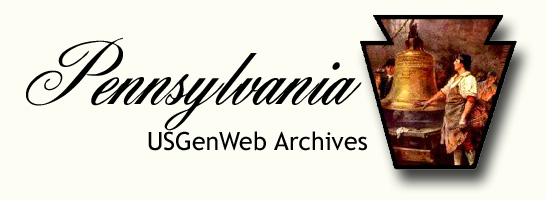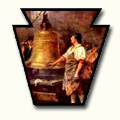| |

Allegheny County
Churches
Diamond Jubilee
1863 - 1938
Saint Augustine Church
Pittsburgh, Pennsylvania
Transcribed and contributed by
Nan Smith
|
printer friendly version of text
|
|
| |
| |
St. Augustine Church Diamond Jubilee
Page 50
CHAPTER IV
The New School—1888
Wisdom hath built herself a house.—Prov. IX, 1
The successor of Father Felix needs no introduction,
for it was Father Maurice Greek who in August, 1887, resumed the pastoral
office. His great task was to erect a new school. As early as March 14, 1886,
Father Felix, the former pastor, had called attention to the necessity of
building a school and for this purpose had purchased the property. At the time
the school was divided, some classes occupying the little frame school and some
the hall. Moreover, with the number of pupils on the increase, both quarters
were becoming more cramped for the children.
The church committee had discussed the question both
with the pastor and among themselves but arrived at no conclusion. It was then
that the practical advice of Father Hyacinth came to the fore. Invited to attend
the meeting of the committee of July 18, 1886, Father Hyacinth prevailed upon
all to favor the erection of a school. He reminded them that the old original
school was badly built—a frame building thrown up overnight in 1861—that there
was no possibility of enlarging it owing to lack of ground, that to try to turn
the hall into a school would be only to aggravate the difficulty. The only
reasonable thing to do was to build a modern and substantial school. The pursual
of Father Hyacinth's suggestion was greatly hastened by a munificent donation
from an altogether unexpected source. On Forty-fourth Street there dwelt an
eighty-four-year-old gentleman by name of Michael McCullough of Londonderry.
Ireland. Grievously ill, he invited Father Gregory Nazianz Schneiders, O.M.Cap.,
one of the local Fathers, to visit him.(1) In the course of one of these visits
the old gentleman, who was considered a millionaire, expressed his intention of
making a substantial donation to some worthy cause. When told that St.
Augustine's Parish was planning to build a school he encouraged the Fathers to
begin the work promising a . donation. Shortly before his death, which occurred
on March 22, 1887, he had called several witnesses to his bedside and had a
check for ten thousand dollars written out to the Building Fund of St.
Augustine's School. Unfortunately, he was too weak to add his signature, hence
in the usual place he traced with a quivering pen a simple cross. The lack of
signature led to complications and a whole year elapsed before the check could
be cashed and then, due to legal claims. Only $8,570 could be collected, with
promise of a little more.(2)
(1) Gregory Nazianz Schneiders was born at Fankel in Prussia on Sept. 18, 1848.
Ordained Aug. 30, 1873 and labored at Liebfrauen in Trier where he was
repeatedly imprisoned for the faith. His position in Germany untenable, his
Bishop advised him to leave the country. He first went to Scotland, arriving
Sept. 2, 1875, and took up residence with a noble family. Here he remained for
three months studying the rudiments of English. He then went to Manchester,
England, and taught at St. Bede's College for five months, whence he went to the
church at Farnworth to be curate for two and a half years. He then became pastor
of Mount Carmel Church, Salford, where he also built a church. On Nov. 11, 1882,
he entered the Capuchin Order in Bavaria. On Jan. 28, 1884, he arrived in the
United States and labored at St. Augustine's, Pittsburgh, till May 2, 1889, when
ill health advised a return to Germany. He died suddenly on Nov. 24, 1905,
whilst preaching a mission. He was a gifted linguist and an eloquent speaker.
Cf. Annales FF. Min. Cap. Prov. Pennsylvaniae. MS. pp. 109. 110. 200; Parish
archives. Jacobs, A., O.M.Cap., Das Totenbuch der Rheinisch-Westfaelischen
Kapuzinerprovinz. Limburg, 1933, p. 333.
(2) Hyacinth Epp: "Die Gemeinden der pennsylvanischen Kapuziner-Provinz", in the
Seraphischer Kinderfreund, IX, pp. 25. MS., II Abschnitt, pp. 65, 66. St. Aug.,
July, 1925, p. 133.
|
|
| |
| |
St. Augustine Church Diamond Jubilee
Page 51
In the spring of 1888 Mr. George Nickel, contractor,
began the excavation. In order to finance the building, Father Maurice suggested
that each self-supporting person take at least one share amounting to fifteen
dollars and to pay this sum within five years. The Capuchin Fathers with the
permission of the Father Provincial took one hundred shares for $1500. This was
done in compensation to the parish for the piece of ground which was to be added
to their convent garden when the frame school should be dismantled. The
parishioners, too, became enthusiastic about the new school and were generous in
purchasing shares. However, of the four hundred and fifty who subscribed, three
hundred and sixty-eight paid either in full or in part. The sum of $14,101 was
collected from this source.
The corner stone was laid on Sunday, July 1, 1888. At
the high Mass the Rev. Gallus Hoch, O.S.B., preached an eloquent sermon on
education through the family, the Church and the School. In the afternoon after
solemn Vespers, the Very Rev. Francis Wolff, O.M.Cap., Provincial,(3) assisted
by the local Capuchins, officiated at the solemn ceremony. The St. Augustinus
Society of young men furnished instrumental music while the church choir and the
school children rendered the singing. In the corner stone were placed a
documentary report of the corner stone laying, several newspapers, a copy of the
Statutes of the Pennsylvania Capuchins, some relics of the saints, medals and an
Agnus Dei.
The building made steady progress and was dedicated on
March 3, 1889. In the morning the Most Reverend John J. Kain, Bishop of
Wheeling, celebrated the Pontifical Mass and preached the sermon. In the
afternoon the same prelate pontificated at Vespers after which the Most Reverend
Richard Phelan, Bishop of Pittsburgh, blessed the school. Father Francis Wolff,
Provincial, delivered the German sermon, contrasting Christian with godless
education. Bishop Kain preached in English, outlining the position of the Church
toward education and toward the State, and deploring in those early days as we
still do today, the double taxation imposed on Catholics. Among the many
clerical guests were: The Reverend Leander Schnerr, O.S.B., Prior of St. Mary's,
Allegheny,(4) Rev. Joseph Strub, C.Sp.S., Provincial of the Holy Ghost Fathers,
the Rev. Fathers Joseph Suehr, Herman Joseph Goebel, and Gregory Zeilnhofer,
O.S.B.(5)
The clergy and other guests were served dinner and
supper in the hall through the generosity of the Frauenheim family. In the
evening a tea party was held for the benefit of the school and on March 5, the
school children staged a play which so impressed the audience that a repetition
was demanded. The income for the school during the days
(3) Francis Wolff was born Dec. 18, 183S, at Ruedesheim, Germany. Entered the
Capuchin Order on Sept. 4, 1858; ordained Aug. 14, 1860; came to the United
States June 11, 1875; returned to Germany in 1897 and died at Ehrenbreitstein on
Dec. 22, 1915. Enzlberger, op. cit., p. 227; Jacobs, A., O.M.Cap., op. cit., p.
361.
(4) Leander Schnerr was born on Jan. 17, 1836, at Gommersdorf, Baden, Germany.
Came to the United States on Aug. 17, 1850. Professed as a Benedictine on Jan.
6, 1857. Ordained Sept. 20, 1859. Pastor of St. Mary's Church, Allegheny, from
Aug. 30. 1877-Aug. 31, 1892. Elected Archabbot of St. Vincent's on July 15,
1892. Died Sept. 3, 1920. Cf. Album Benedictinum, St. Vincent's. Pa., 1880, p.
336; Gedenkbuch des Gold. ]ub. der St. Marien-Kirche, Pittsburgh, 1898, ?.
67-91, 117. Daller, Lambert. O.S.B., Diamond Jubilee Celebration of St. Mary's
Church, N. S.. Pittsburgh, 1923, pp. 38-41, 44-47; Enzlberger, op. cit., p. 240.
(5) Rt. Rev. Joseph Suehr was born March 12, 1847 at Dinsheim, Alsace. Came to
the United j:i:e; on Dec. 25, 1853, and was ordained in Pittsburgh, July 31,
1870. In 1878 became pastor of SS. Peter and Paul's Church, East End, and kept
this office till his death on March 9, 1922. For many years he was Vicar General
for the Germans of the diocese. Made Monsignor and later Prothonotary Apostolic.
Enzlberger, op. cit., 238; Rt. Rev. Herman Jos. Goebel was born March 19. 1853,
at Niederhelden in Westphalia. Germany. Came to the United States on May 17.
1872; ordained in Pittsburgh on April 21, 1876. Pastor of St. Martin's Church,
West End in Sept.. 1877. Died as Monsignor and pastor of St. Joseph's Church,
Mt. Oliver, on June 3. 1925. Enzlberger, op. cit., 239.
Rev. Gregory Zeilnhofer was born on April 1, 1861, at Obersiebach. Came to the
United States on March 29. 1879. Ordained July 8, 1886. Curate at St. Mary's, N.
S., from Aug., 1886-Feb. 1892. Thereafter he labored in Carrolltown, Pa., and in
Canon City, Col. He died Sept. 13, 1911 at Johnstown, Pa. Enzlberger, op. cit.,
242; Gedenkbuch der St. Marien-Kirche, N. S., p. 119. Daller, op. cit., pp. 46,
70.
|
|
| |
| |
St. Augustine Church Diamond Jubilee
Page 52

Plot of Property bought by Hoeveler, Unverzagt, Wirth in 1860;
included also is property bought in 1862 and later for present School,
Sister's Convent and Casino.
|
|
| |
| |
St. Augustine Church Diamond Jubilee
Page 53
of dedication bordered on the magnificent sum of two
thousand dollars. This was most welcome to Father Maurice, the pastor, who
amidst all the joy of the occasion could not forget that the building of the
school had added thousands of dollars to the church debt. The mere shell
cost $32,900, but the heating, lighting, and general equipment brought the
total to $45,000.(6) On February 16, 1894, the Clipper(7) carried the
following reference to St. Augustine's new school:
In 1888 the new school house, on Thirty-seventh Street
was erected at a cost of $45,000. It is one of the most complete buildings
of its kind in the city if not in the western part of the state. It contains
12 spacious school rooms, four additional rooms in the basement. The main
entrance is on Thirty-seventh Street. The doors open into a spacious
vestibule or hall, and wide stairways lead up on either side, to the second
floor. The building is handsomely finished throughout; it is heated by steam
and has every required equipment for school work. The following gentlemen
served on the building committee: A. Schillo. P. Kirner, L. Krekeler, A.
Frauenheim, Wm. A. Heyl. Moeser was the architect and George Nickel the
contractor.
The people of St. Augustine's must ever be grateful for
their school, for from the very beginning no effort was spared to equip it
according to the best standards of the time. In the beginning and before the
days of standardization there were twelve grades in which the regular
curriculum was taught in the usual thorough fashion for which the Germans
are noted. In 1892 Father Joseph Anthony introduced the academy for the
girls and in 1894 for the boys. It comprised the three highest grades and
was a kind of high school which aimed at equipping the pupils for positions
in the business world. Besides a more intensive training in the usual
branches, the pupils received a course in bookkeeping, stenography and
typewriting. Only talented pupils were admitted to the academy.
One great advantage in attending St. Augustine's School
was the opportunity afforded the pupils to learn both English and German.
Even in the early years children of other parishes enrolled at St.
Augustine's chiefly to learn German. In 1890 the number of pupils reached
about 600 and from then on the number varies between 600 and 700. Of course,
the success of the school in disseminating true knowledge and in developing
genuine character that is a credit to both Church and State, is due in no
small measure to the staff of teachers that have honored the profession
there for the last sixty-seven years. Writing in 1906 on the school Father
Hyacinth says:
The achievements of the Sisters are worthy of all
praise and are not behind those of the State Schools, despite the fact that
the Sisters teach in two languages and the additional branch of religion.(8)
The number of Sisters that taught at the school from
1871 to date is approximately 643. Sister Ambrosia was one of the most
outstanding teachers in the history of the school and taught there for
twenty years— 1884-1904. She died on September 11, 1907, as bursar of St.
Francis Hospital. To date there have been nineteen Sisters who served in the
capacity of Superior.(9) From 1912-1925 the textbooks compiled by Sister M.
Clarissa were used.
Anxious to lessen the burdens entailed in education,
Father Agatho Rolf, O.M.Cap., abolished in 1906 the monthly tuition fee of
fifty cents for all the grades save the academy. He also improved the
curriculum and laid more stress on English composition. The writer well
remembers how Father Agatho went through the school the very first month of
its opening, announcing a contest in English composition and offering a
prize for the best essay in each grade.
Other pastors, too, took special interest in the school
and its development. Father
(6) Hyacinth Epp., Seraphischer Kinderfreund, IX, p. 25.
(7) A local paper. Shortlived.
(8) Hyacinth Epp, MS., II Abschnitt. p. 70.
(9) Sisters: M. Agnes, 1876-1879; M. Dolores, 1878-1882; M. Paschala,
1882-1884; M. Juliane, 1884-1886; M. Cleopha, 1886-1892; M. Juliane,
1892-1895; M. Ligouri, 1895-1901; M. Ambrosia, 1901-1904; M. Anthony,
1904-1907; M. Gertrude, 1907-1910; M. Teresita, 1910-1912; M. Celestine,
1912-1913; Mother M. Agnes, 1913-1915; M. Ligouri, 1915-1916; M. Aurelia,
1916-1918; M. Callista, 1918-1924; M. Gertrude, 1924-1930; M. Antoinette,
1930-1935; M. Victorine,1935-. Chronicle, St. Francis Convent, Millvale.
Information by Sister M. Clarissa.
|
|
| |
| |
St. Augustine Church Diamond Jubilee
Page 54
Philip Knupfer, O.M.Cap., improved the curriculum and the
equipment especially in the higher grades. In order to stimulate diligence
on the part of the academy pupils and incidentally to help the poor he
started the scholarship fund. Time and again he appealed through the pages
of the St. Augustinus for donations of twenty dollars for scholarships and
in answer, complete or partial scholarships were established. In 1923,
Father Philip installed the electric light and had the interior of the
school painted. Anxious to improve the curriculum again and thus fit the
graduates for better clerical positions he purchased in 1924 for the
commercial department two comptometers—machines which add, subtract,
multiply and divide. For a period two instructors came daily to the school
to instruct both teacher and pupil in the operation. The expenditure for
these machines was $600. It might be added that St. Augustine's School was a
pioneer in this forward step. The fruits of these efforts were soon seen in
the interest which the pupils took in their studies. Self-reliance and
wholesome rivalry developed as is seen from the various occasions when
pupils of St. Augustine's School won prizes in essay contests. Some of these
contests embraced all public and parochial schools in the State of
Pennsylvania.
The latest substantial development in the educational
facilities of St. Augustine's School is the four-year high school for girls
opened by Father Ferdinand Hartung, O.M.Cap., in September, 1931. The boys
of the parish had found a similar opportunity at the Catholic Central High
School erected with the funds of the diocesan educational campaign in 1924.
The Most Reverend Bishop Boyle had granted permission for St. Augustine's
High School for girls and it became immediately popular in the parish.
The year 1938 marks not only the diamond jubilee of the
church but also the golden jubilee of the school. Erected in 1888, the
venerable building has weathered successfully the storms of a half century.
During all these years the school required no major repairs, a proof of its
substantial character. Father Florence Kirchgessner, O.M.Cap., the present
pastor, has renovated the front of the building in preparation for the
diamond jubilee of the church. In the course of time he hopes to modernize
the school still more and bring it up to the present standards of school
buildings.
|
|
|
| |
Return to Top of Page
Return to Allegheny County Archives Index Page
Martha A C Graham,
Allegheny County Archives File Manager
Copyright 2011 - Present, USGenWeb Archives
|
|
|




